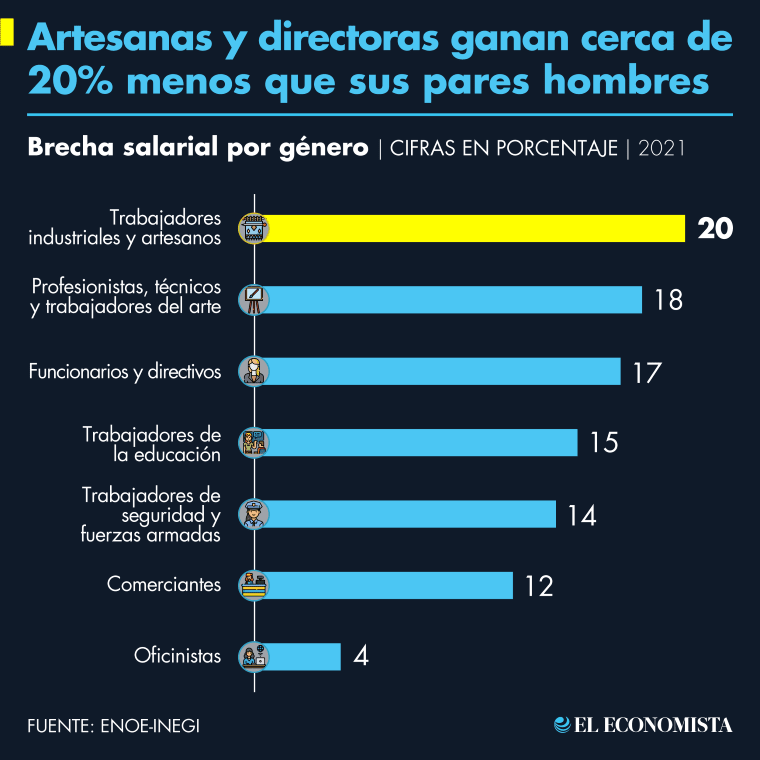November 25 is the International Day for the Elimination of Violence against Women and Girls and until December 10 (Human Rights Day) 16 days of collective and global activism are celebrated to make visible and eradicate all expressions of gender violence.
When you talk about violence against women and girlsNot only are femicides, sexual and physical assaults or harassment on the streets, social networks or even at work put on the table. Inequalities and discrimination are also a form of violence and, in fact, persist, strengthening the systematic structures that result in between 9 and 11 women being murdered every day in Mexico.
These inequalities were pronounced in an important way with the Covid-19 pandemic and although a large part of the labor market has been reactivated in terms of gender, there are still some pending. According to figures from the ENOE (National Survey of Occupation and Employment) of the Inegi, women receive lower wages and salaries for the same work than men, have a higher incidence of employment in unskilled positions even when they do have professional studies, occupy only 30% of the best-paid positions and do almost all the care work and from home (paid and unpaid).
On average, women work 60.5 hours a week, both in economic and non-economic activities, while the average for men is 51.4; This situation reflects a gap of almost 10 points, according to ENOE figures updated to the third quarter of 2021.
But things get worse for women who are not economically active, who work a total of 34.6 hours a week, while men in the same condition work 18.4 hours.
But just because they work more doesn’t mean they get paid more. Industrial workers, artisans and helpers face a 20% wage gap, while professionals, technicians and art workers earn 18% less than their male counterparts, civil servants and managers in the public, private and social sectors 17% less.

Although slightly smaller, these wage gaps persist in other productive sectors such as commerce, education, health and social services, and even in public security and surveillance tasks.
These numbers reaffirm what has been studied by specialists, activists and organizations for some decades now: women can now study and work, but this has not translated into a equitable sharing the other job, the home, the unpaid. Additionally, women who manage to enter the paid labor market continue to face discrimination and unequal opportunities.
Paid work from home
Another of the persistent problems, which has not been left behind even with the economic recovery after Covid-19, is the unemployment and vulnerability of the paid domestic workers.
Since before the pandemic, this occupation was already one of the most important tasks in terms of labor rights and social protection: almost 95% of these jobs are held by women and more than 90% of them are carried out informally.
This means that almost all domestic workers in Mexico do not have contracts, social security, access to health institutions, Christmas bonus, vacations or any job protection or guarantee. In many cases, their income is not even guaranteed because they depend on the job offer of their employers.
In other situations, domestic workers are in “plant” situations, an even more alarming situation; which implies that they do not have established working hours, limits on the tasks to be performed or even do not have right to disconnect.
But even with all these work vulnerabilities, many women access these jobs because it is the only possibility of generating income: more than 30% of paid domestic workers is the head of the household where they live. And on average they earn between 1 and 2 minimum wages, according to figures from the ENOE.
Following the Inegi data, it is observed that compared to the same period of 2019, before the pandemic, there are now 262,439 less population employed in paid domestic work. Additionally, no increases are reported in other forms of informality or economic sectors, which does not suggest that these workers could have moved to some other paid occupation.
Vulnerabilities in employment and free time produce significant gaps in income and in the ability to access culture, recreation, education or leisure. Women, in general, face significant obstacles to achieving economic independence, leading their own projects and balancing their personal lives with professional growth. For indigenous, black, transsexual or rural women the situation is worse.
Eradicating violence also implies eradicating all gender stereotypes and discrimination that reinforce the structures under which attacks on women and girls deepen.
Reference-www.eleconomista.com.mx